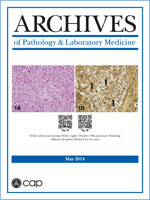Kudos to CAP and Archives of Pathology and Laboratory Medicine
This month’s issue of Archives of Pathology and Laboratory Medicine has an article entitled “Pulmonary Large Cell Carcinoma Lacking Sqaumous Differentiation Is Clinicopathologically Indistinguishable From Solid-Subtype Adenocarcinoma” with an accompanying editorial by Drs. Cagle and Glassy on the use of whole slide images incorporated through links and QR codes in the paper.
The images are viewed using CAP’s DigitalScope. Here is an example:
http://www.digitalscope.org/Viewer.aspx?SlideId=34c888aa-3df1-4df2-b9bb-5d6002c0e3c8
The incorporation of whole slide images, fulfilling one of the most valuable and cost-effective ways to educate and inform the pathology public has been a long-time coming.
With many advances in publishing in recent years with multiple formats and applications for both submission and viewing with desktop and mobile viewing, this may represent the single most important upgrade for pathology journals. As readers, we can now appreciate more than a snapshot to support findings or conclusions and be more directly involved in approach to lesions described that support or refute contributors’ results and conclusions.
There is no doubt this is an excellent use of digital pathology technologies illustrating a journal article, beyond the traditional use of static imaging alone, showcasing a simple yet effective way to further educate and inform pathologists.
Many of us can still recall the necessity of returning glass slides mailed months previously at the time of a meeting in order to obtain a course syllabus and perhaps a set of kodachrome slides and even perhaps risk not obtaining CME credit without return of the glass slides.
Digital pathology technologies such as those used in this article highlight the value of whole slide images and their value to the pathology community. Continued advances in scanning, storing and viewing along with advances in how textual information is delivered and viewed will only continue to enhance the value of whole slide images rather than representative figures.
Thank you to the College of American Pathologists and the Archives of Pathology and Laboratory Medicine for your thought, vision and leadership in this effort.



































